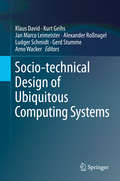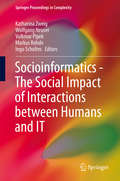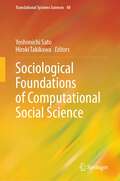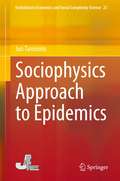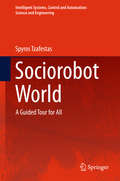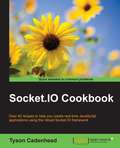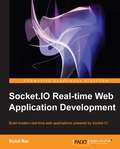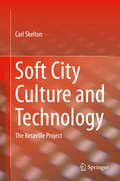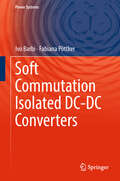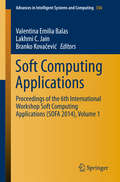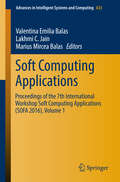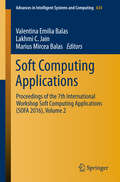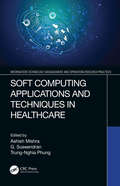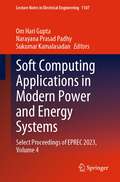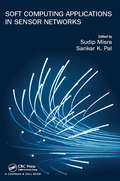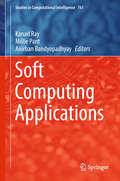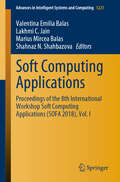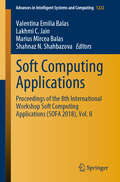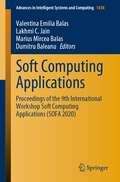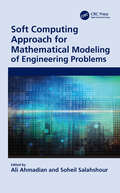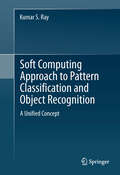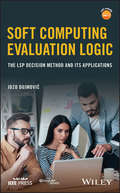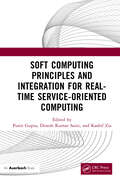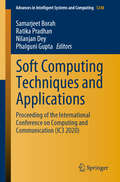- Table View
- List View
Socio-technical Design of Ubiquitous Computing Systems
by Alexander Roßnagel Gerd Stumme Jan Marco Leimeister Klaus David Kurt Geihs Ludger Schmidt Arno WackerBy using various data inputs, ubiquitous computing systems detect their current usage context, automatically adapt their services to the user's situational needs and interact with other services or resources in their environment on an ad-hoc basis. Designing such self-adaptive, context-aware knowledge processing systems is, in itself, a formidable challenge. This book presents core findings from the VENUS project at the Interdisciplinary Research Center for Information System Design (ITeG) at Kassel University, where researchers from different fields, such as computer science, information systems, human-computer interaction and law, together seek to find general principles and guidelines for the design of socially aware ubiquitous computing systems. To this end, system usability, user trust in the technology and adherence to privacy laws and regulations were treated as particularly important criteria in the context of socio-technical system design. During the project, a comprehensive blueprint for systematic, interdisciplinary software development was developed, covering the particular functional and non-functional design aspects of ubiquitous computing at the interface between technology and human beings. The organization of the book reflects the structure of the VENUS work program. After an introductory part I, part II provides the groundwork for VENUS by presenting foundational results from all four disciplines involved. Subsequently, part III focuses on methodological research funneling the development activities into a common framework. Part IV then covers the design of the demonstrators that were built in order to develop and evaluate the VENUS method. Finally, part V is dedicated to the evaluation phase to assess the user acceptance of the new approach and applications. The presented findings are especially important for researchers in computer science, information systems, and human-computer interaction, but also for everyone working on the acceptance of new technologies in society in general.
Socioinformatics - The Social Impact of Interactions between Humans and IT
by Katharina Zweig Wolfgang Neuser Volkmar Pipek Markus Rohde Ingo ScholtesSocioinformatics is a new scientific approach to study the interactions between humans and IT. These proceedings are a collection of the contributions during a workshop of the Gesellschaft für Informatik (GI). Researchers in this emerging field discuss the main aspects of interactions between IT and humans with respect to; social connections, social changes, acceptance of IT and the social conditions affecting this acceptance, effects of IT on humans and in response changes of IT, structures of the society and the influence of IT on these structures, changes of metaphysics influenced by IT and the social context of a knowledge society.
Sociological Foundations of Computational Social Science (Translational Systems Sciences #40)
by Yoshimichi Sato Hiroki TakikawaThis book provides solid sociological foundations to computational social science (CSS). CSS is an emerging research field, and many books with those words in the title are on the market. However, CSS has not become mainstream in sociology, for which there are two reasons. First, CSS does not necessarily solve major research questions in sociology. Second, its sociological foundations are weak. These two reasons are interrelated—that is, CSS cannot solve major research questions because its sociological foundations are weak. Thus, even if it tries to solve those questions, its approaches seem to mainstream sociologists to miss the point. To resolve that shortcoming, this book fills the gap between CSS and sociology, shows that CSS can solve major research questions in sociology, and advances sociology by introducing to it theories and methodologies of CSS.
Sociophysics Approach to Epidemics (Evolutionary Economics and Social Complexity Science #23)
by Jun TanimotoThis book presents the fundamentals of evolutionary game theory and applies them to the analysis of epidemics, which is of paramount importance in the aftermath of the worldwide COVID-19 pandemic. The primary objective of this monograph is to deliver a powerful tool to model and analyze the spread of an infectious disease during a pandemic as well as the human decision dynamics. The book employs a variant of the “vaccination game,” in which a mathematical epidemiological model dovetails with evolutionary game theory. From a social physics standpoint, this book introduces an extended concept of the vaccination game starting from the fundamental issues and touching on the newest practical applications.The book first outlines the fundamental basis of evolutionary game theory, in which a two-player and two-strategy game, the so-called 2 × 2 game, and a multi-player game are concisely introduced, and the important issue of how social dilemmas are quantified is highlighted. Subsequently, the book discusses various recent applications of the extended concept of the vaccination game so as to quantitatively evaluate provisions other than vaccination, including practical intermediate protective measures such as mask-wearing, efficiency of quarantine compared with that of isolation policies for suppressing epidemics, efficiency of preemptive versus late vaccination, and optimal subsidy policies for vaccination.
Sociorobot World
by Spyros TzafestasThis book makes a consolidated guided tour to the world of sociorobots (social or socialized robots). Sociorobots and assistive robots provide entertainment, assistance to the handicapped, companionship to the elderly and health care to autistic children and people with dementia. The book provides, in a fluent educational way, all major concepts, architectures and design methodologies. All types of sociorobots are examined, namely walking anthropomorphic, wheeled anthropomorphic, fixed-place anthropomorphic and zoomorphic sociorobots. The book provides an outline of sociorobot intelligent control architectures, robot learning and human robot interaction.
Socket.IO Cookbook
by Tyson CadenheadOver 40 recipes to help you create real-time JavaScript applications using the robust Socket.IO framework About This Book * Create secure WebSocket connections and real-time mobile applications using Socket.IO * Devise efficient messaging systems between the server side and the client side * A step-by-step implementation guide to help you create elements of Socket.IO application Who This Book Is For If you have some knowledge of JavaScript and Node.js and want to create awe-inspiring application experiences using real time communication, then this book is for you. Developers with knowledge of other scripting languages should also be able to easily follow along. What You Will Learn * Build rich and interactive real-time dashboards using Socket.IO to pipe in data as it becomes available * Design chat and multiple-person interfaces that leverage Socket.IO for communication * Segment conversations to rooms and namespaces so that every socket doesn't have to receive every message * Secure your data by implementing various authentication techniques, locking down the HTTP referrer and using secure WebSockets * Load balance across multiple server-side nodes and keep your WebSockets in sync using Redis, RabbitMQ or Memcached * Stream binary data such as audio and video in real-time over a Socket.IO connection * Create real-time experiences outside of the browser by integrating Socket.IO with hybrid mobile applications In Detail Socket.IO is a JavaScript library that provides you with the ability to implement real-time analytics, binary streaming, instant messaging, and document collaboration. It has two parts: a client-side library that runs in the browser, and a server-side library for node.js. Socket.IO is event-driven and primarily uses the WebSocket protocol that allows us to emit data bi-directionally from the server and the client. Socket.IO This book is a complete resource, covering topics from webSocket security to scaling the server-side of a Socket.IO application and everything in between. This book will provide real-world examples of how secure bi-directional, full-duplex connections that can be created using Socket.IO for different environments. It will also explain how the connection vulnerabilities can be resolved for large numbers of users and huge amounts of data/messages. By the end of the book, you will be a competent Socket.IO developer. With the help of the examples and real-world solutions,you will learn to create fast, scalable, and dynamic real-time apps by creating efficient messaging systems between the server side and the client side using Socket.IO. Style and approach This book is written in a cookbook-style format and provides practical, immediately usable task-based recipes that show you how to create the elements of a Socket.IO application.
Socket.io Real-time Web Application Development
by Rohit RaiWritten in an engaging, easy-to-follow style, "Socket.io Real-time Web Application Development" is a practical guide for developing real-time web applications with Node.js and socket.io.This book is aimed at developers who want to start developing highly interactive and real-time web applications like chat systems or online multiplayer games, or want to introduce real-time updates or server push mechanisms in their existing applications. Knowledge of developing in JavaScript and web applications in general is expected. Though there is a chapter on introducing Node.js, prior knowledge of Node.js will be a plus.
Soft & Cuddly (Boss Fight Books)
by Jarett KobekA computer game so nauseatingly gory that it came with a barf bag. Bright druggy graphics that sickened scores of proper English parents. Gameplay so violent that it inspired one of Britain's most infamous killing sprees. Soft & Cuddly, released for the ZX Spectrum in 1987, wasn't quite any of these things. But in an age of manufactured moral panics, John George Jones's fluorescent punk manifesto sure pissed off a lot of people. Featuring new interviews with the game's creator, Jarett Kobek's book dives deep into the gritty world of British yellow journalism, snarky computer fanzines, DIY home programming, and Soviet bootleg mixtapes. If Margaret Thatcher's Conservative Party was right that video nasties like Soft & Cuddly were the epitome of 80s depravity, then this book is headed straight to Hell.
Soft City Culture and Technology
by Carl SkeltonSoft City Culture and Technology: The Betaville Project discusses the complete cycle of conception, development, and deployment of the Betaville platform. Betaville is a massively participatory online environment for distributed 3D design and development of proposals for changes to the built environment- an experimental integration of art, design, and software development for the public realm. Through a detailed account of Betaville from a Big Crazy Idea to a working "deep social medium", the author examines the current conditions of performance and accessibility of hardware, software, networks, and skills that can be brought together into a new form of open public design and deliberation space, for and spanning and integrating the disparate spheres of art, architecture, social media, and engineering. Betaville is an ambitious enterprise, of building compelling and constructive working relationships in situations where roles and disciplinary boundaries must be as agile as the development process of the software itself. Through a considered account and analysis of the interdependencies between Betaville's project design, development methods, and deployment, the reader can gain a deeper understanding of the potential socio-technical forms of New Soft Cities: blended virtual-physical worlds, whose "public works" must ultimately serve and succeed as massively collaborative works of art and infrastructure.
Soft Commutation Isolated DC-DC Converters (Power Systems)
by Ivo Barbi Fabiana PöttkerThis book describes the operation and analysis of soft-commutated isolated DC–DC converters used in the design of high efficiency and high power density equipment. It explains the basic principles behind first- and second-order circuits with power switches to enable readers to understand the importance of these converters in high efficiency and high power density power supply design for residential, commercial, industrial and medical use as well as in aerospace equipment.With each chapter featuring a different power converter topology, the book covers the most important resonant converters, including series resonant converters; resonant LLC converters; soft commutation pulse width modulation converters; zero voltage switching; and zero current switching. Each topic is presented with full analysis, a showcase of the power stages of the converters, exercises and their solutions as well as simulation results, which mainly focus on the commutation analysis and output characteristic.This book is a valuable source of information for professionals working in power electronics, power conversion and design of high efficiency and high power density DC–DC converters and switch mode power supplies. The book also serves as a point of reference for engineers responsible for development projects and equipment in companies and research centers and a text for advanced students.
Soft Computing Applications
by Lakhmi C. Jain Branko Kovačević Valentina Emilia BalasThese volumes constitute the Proceedings of the 6th International Workshop on Soft Computing Applications, or SOFA 2014, held on 24-26 July 2014 in Timisoara, Romania. This edition was organized by the University of Belgrade, Serbia in conjunction with Romanian Society of Control Engineering and Technical Informatics (SRAIT) - Arad Section, The General Association of Engineers in Romania - Arad Section, Institute of Computer Science, Iasi Branch of the Romanian Academy and IEEE Romanian Section. The Soft Computing concept was introduced by Lotfi Zadeh in 1991 and serves to highlight the emergence of computing methodologies in which the accent is on exploiting the tolerance for imprecision and uncertainty to achieve tractability, robustness and low solution cost. Soft computing facilitates the use of fuzzy logic, neurocomputing, evolutionary computing and probabilistic computing in combination, leading to the concept of hybrid intelligent systems. The combination of such intelligent systems tools and a large number of applications introduce a need for a synergy of scientific and technological disciplines in order to show the great potential of Soft Computing in all domains. The conference papers included in these proceedings, published post conference, were grouped into the following area of research: · Image, Text and Signal Processing Intelligent Transportation Modeling and Applications Biomedical Applications Neural Network and Applications Knowledge-Based Technologies for Web Applications, Cloud Computing, Security, Algorithms and Computer Networks Knowledge-Based Technologies Soft Computing Techniques for Time Series Analysis Soft Computing and Fuzzy Logic in Biometrics Fuzzy Applications Theory and Fuzzy Control Business Process Management Methods and Applications in Electrical Engineering The volumes provide useful information to professors, researchers and graduated students in area of soft computing techniques and applications, as they report new research work on challenging issues.
Soft Computing Applications
by Lakhmi C. Jain Valentina Emilia Balas Marius Mircea BalasIntelligent agents are one of the most promising business tools in our information rich world. An intelligent agent consists of a software system capable of performing intelligent tasks within a dynamic and unpredictable environment. They can be characterised by various attributes including: autonomous, adaptive, collaborative, communicative, mobile, and reactive. Many problems are not well defined and the information needed to make decisions is not available. These problems are not easy to solve using conventional computing approaches. Here, the intelligent agent paradigm may play a major role in helping to solve these problems. This book, written for application researchers, covers a broad selection of research results that demonstrate, in an authoritative and clear manner, the applications of agents within our information society.
Soft Computing Applications
by Lakhmi C. Jain Valentina Emilia Balas Marius Mircea BalasIntelligent agents are one of the most promising business tools in our information rich world. An intelligent agent consists of a software system capable of performing intelligent tasks within a dynamic and unpredictable environment. They can be characterised by various attributes including: autonomous, adaptive, collaborative, communicative, mobile, and reactive. Many problems are not well defined and the information needed to make decisions is not available. These problems are not easy to solve using conventional computing approaches. Here, the intelligent agent paradigm may play a major role in helping to solve these problems. This book, written for application researchers, covers a broad selection of research results that demonstrate, in an authoritative and clear manner, the applications of agents within our information society.
Soft Computing Applications and Techniques in Healthcare (Information Technology, Management and Operations Research Practices)
by Trung-Nghia Phung G. Suseendran Ashish MishraThis book provides insights into contemporary issues and challenges in soft computing applications and techniques in healthcare. It will be a useful guide to identify, categorise and assess the role of different soft computing techniques for disease, diagnosis and prediction due to technological advancements. The book explores applications in soft computing and covers empirical properties of artificial neural network (ANN), evolutionary computing, fuzzy logic and statistical techniques. It presents basic and advanced concepts to help beginners and industry professionals get up to speed on the latest developments in soft computing and healthcare systems. It incorporates the latest methodologies and challenges facing soft computing, examines descriptive, predictive and social network techniques and discusses analytics tools and their role in providing effective solutions for science and technology. The primary users for the book include researchers, academicians, postgraduate students, specialists and practitioners. Dr. Ashish Mishra is a professor in the Department of Computer Science and Engineering, Gyan Ganga Institute of Technology and Sciences, Jabalpur, Madhya Pradesh, India. He has contributed in organising the INSPIRE Science Internship Camp. He is a member of the Institute of Electrical and Electronics Engineers and is a life member of the Computer Society of India. His research interests include the Internet of Things, data mining, cloud computing, image processing and knowledge-based systems. He holds nine patents in Intellectual Property, India. He has authored four books in the areas of data mining, image processing and LaTex. Dr. G. Suseendran is an assistant professor, Department of Information Technology, School of Computing Sciences, Vels Institute of Science, Technology & Advanced Studies (VISTAS), Chennai, Tamil Nadu, India. His research interests include ad-hoc networks, the Internet of Things, data mining, cloud computing, image processing, knowledge-based systems, and Web information exploration. He has published more than 75 research papers in various international journals such as Science Citation Index, Springer Book Chapter, Scopus, IEEE Access and UGC-referred journals. Prof. Trung-Nghia Phung is an associate professor and Head of Academic Affairs, Thai Nguyen University of Information and Communication Technology (ICTU). He has published more than 60 research papers. His main research interest lies in the field of speech, audio, and biomedical signal processing. He serves as a technical committee program member, track chair, session chair, and reviewer of many international conferences and journals. He was a co-Chair of the International Conference on Advances in Information and Communication Technology 2016 (ICTA 2016) and a Session Chair of the 4th International Conference on Information System Design and Intelligent Applications (INDIA 2017).
Soft Computing Applications in Modern Power and Energy Systems: Select Proceedings of EPREC 2023, Volume 4 (Lecture Notes in Electrical Engineering #1107)
by Om Hari Gupta Narayana Prasad Padhy Sukumar KamalasadanThis book includes select proceedings of EPREC 2023. It provides rigorous discussions, case studies, and recent developments in the areas of soft computing and its applications in power systems enabled with power electronics-based equipment, energy systems, and the energy community. The other topics to be covered are optimal planning, analysis, operation, and control related to modern power and energy systems, and applications of various soft computing methodologies. The readers find this book useful for enhancing their knowledge and skills in the domain areas.
Soft Computing Applications in Sensor Networks
by Sudip Misra and Sankar K. PalThis book uses tutorials and new material to describe the basic concepts of soft-computing which potentially can be used in real-life sensor network applications. It is organized in a manner that exemplifies the use of an assortment of soft-computing applications for solving different problems in sensor networking. Written by worldwide experts, the chapters provide a balanced mixture of different problems concerning channel access, routing, coverage, localization, lifetime maximization and target tracking using emerging soft-computing applications.
Soft Computing Applications: Proceedings Of Socta 2016, Volume 1 (Advances In Intelligent Systems And Computing #583)
by Millie Pant Kanad Ray Anirban BandyopadhyayThis book provides a reference guide for researchers, scientists and industrialists working in the area of soft computing, and highlights the latest advances in and applications of soft computing techniques in multidisciplinary areas. Gathering papers presented at the International Conference on Soft Computing: Theories and Applications (SoCTA 2016), which was held in Jaipur, Rajasthan, India, on December 28–30, 2016, it focuses on applying soft computing to solve real-life problems arising in various domains, from medical and healthcare to supply chain management, image processing and cryptanalysis. The term soft computing represents an umbrella term for computational techniques like fuzzy logic, neural networks and nature inspired algorithms. In the past few decades, there has been an exponential rise in the application of soft computing techniques to address complex and intricate problems in diverse spheres of life. The versatility of these techniques has made them a favourite among scientists and researchers alike.
Soft Computing Applications: Proceedings of the 8th International Workshop Soft Computing Applications (SOFA 2018), Vol. I (Advances in Intelligent Systems and Computing #1221)
by Lakhmi C. Jain Valentina Emilia Balas Shahnaz N. Shahbazova Marius Mircea BalasThis book presents the proceedings of the 8th International Workshop on Soft Computing Applications, SOFA 2018, held on 13–15 September 2018 in Arad, Romania. The workshop was organized by Aurel Vlaicu University of Arad, in conjunction with the Institute of Computer Science, Iasi Branch of the Romanian Academy, IEEE Romanian Section, Romanian Society of Control Engineering and Technical Informatics – Arad Section, General Association of Engineers in Romania – Arad Section and BTM Resources Arad.The papers included in these proceedings, published post-conference, cover the research including Knowledge-Based Technologies for Web Applications, Cloud Computing, Security Algorithms and Computer Networks, Business Process Management, Computational Intelligence in Education and Modelling and Applications in Textiles and many other areas related to the Soft Computing.The book is directed to professors, researchers, and graduate students in area of soft computing techniques and applications.
Soft Computing Applications: Proceedings of the 8th International Workshop Soft Computing Applications (SOFA 2018), Vol. II (Advances in Intelligent Systems and Computing #1222)
by Lakhmi C. Jain Valentina Emilia Balas Shahnaz N. Shahbazova Marius Mircea BalasThis book presents the proceedings of the 8th International Workshop on Soft Computing Applications, SOFA 2018, held on 13–15 September 2018 in Arad, Romania. The workshop was organized by Aurel Vlaicu University of Arad, in conjunction with the Institute of Computer Science, Iasi Branch of the Romanian Academy, IEEE Romanian Section, Romanian Society of Control Engineering and Technical Informatics – Arad Section, General Association of Engineers in Romania – Arad Section and BTM Resources Arad.The papers included in these proceedings, published post-conference, cover the research including Knowledge-Based Technologies for Web Applications, Cloud Computing, Security Algorithms and Computer Networks, Business Process Management, Computational Intelligence in Education and Modelling and Applications in Textiles and many other areas related to the Soft Computing.The book is directed to professors, researchers, and graduate students in area of soft computing techniques and applications.
Soft Computing Applications: Proceedings of the 9th International Workshop Soft Computing Applications (SOFA 2020) (Advances in Intelligent Systems and Computing #1438)
by Lakhmi C. Jain Dumitru Baleanu Valentina Emilia Balas Marius Mircea BalasSoft computing techniques open significant opportunities in several areas, such as industry, medicine, energy, security, transportation, and education. This book provides theory and applications development using soft computing techniques by organizing intelligent systems for many applications to the benefit of humanity. The book comes from a multidisciplinary subject whose audience can come from different academic departments, e.g., department of computer science and engineering, department of medical imaging, department of biomedical informatics, department of education sciences, and so on where artificial intelligence and soft computing are of routine courses. The book covers a range of audience from academicians, practitioners, researchers, and students to stakeholders. It can support graduate students and interns to develop a deep understanding of the latest paradigms in the soft computing techniques.
Soft Computing Approach for Mathematical Modeling of Engineering Problems
by Ali AhmadianThis book describes different mathematical modeling and soft computing techniques used to solve practical engineering problems. It gives an overview of the current state of soft computing techniques and describes the advantages and disadvantages of soft computing compared to traditional hard computing techniques. Through examples and case studies the editors demonstrate and describe how problems with inherent uncertainty can be addressed and eventually solved through the aid of numerical models and methods. The chapters address several applications and examples in bioengineering science, drug delivery, solving inventory issues, Industry 4.0, augmented reality and weather forecasting. Other examples include solving fuzzy-shortest-path problems by introducing a new distance and ranking functions. Because, in practice, problems arise with uncertain data and most of them cannot be solved exactly and easily, the main objective is to develop models that deliver solutions with the aid of numerical methods. This is the reason behind investigating soft numerical computing in dynamic systems. Having this in mind, the authors and editors have considered error of approximation and have discussed several common types of errors and their propagations. Moreover, they have explained the numerical methods, along with convergence and consistence properties and characteristics, as the main objectives behind this book involve considering, discussing and proving related theorems within the setting of soft computing. This book examines dynamic models, and how time is fundamental to the structure of the model and data as well as the understanding of how a process unfolds • Discusses mathematical modeling with soft computing and the implementations of uncertain mathematical models • Examines how uncertain dynamic systems models include uncertain state, uncertain state space and uncertain state’s transition functions • Assists readers to become familiar with many soft numerical methods to simulate the solution function’s behaviorThis book is intended for system specialists who are interested in dynamic systems that operate at different time scales. The book can be used by engineering students, researchers and professionals in control and finite element fields as well as all engineering, applied mathematics, economics and computer science interested in dynamic and uncertain systems. Ali Ahmadian is a Senior Lecturer at the Institute of IR 4.0, The National University of Malaysia.Soheil Salahshour is an associate professor at Bahcesehir University.
Soft Computing Approach to Pattern Classification and Object Recognition
by Kumar S. RaySoft Computing Approach to Pattern Classification and Object Recognition establishes an innovative, unified approach to supervised pattern classification and model-based occluded object recognition. The book also surveys various soft computing tools, fuzzy relational calculus (FRC), genetic algorithm (GA) and multilayer perceptron (MLP) to provide a strong foundation for the reader. The supervised approach to pattern classification and model-based approach to occluded object recognition are treated in one framework , one based on either a conventional interpretation or a new interpretation of multidimensional fuzzy implication (MFI) and a novel notion of fuzzy pattern vector (FPV). By combining practice and theory, a completely independent design methodology was developed in conjunction with this supervised approach on a unified framework, and then tested thoroughly against both synthetic and real-life data. In the field of soft computing, such an application-oriented design study is unique in nature. The monograph essentially mimics the cognitive process of human decision making, and carries a message of perceptual integrity in representational diversity. Soft Computing Approach to Pattern Classification and Object Recognition is intended for researchers in the area of pattern classification and computer vision. Other academics and practitioners will also find the book valuable.
Soft Computing Evaluation Logic: The LSP Decision Method and Its Applications (Wiley - IEEE)
by Jozo DujmovićA novel approach to decision engineering, with a verified framework for modeling human reasoning Soft Computing Evaluation Logic provides an in-depth examination of evaluation decision problems and presents comprehensive guidance toward the use of the Logic Scoring of Preference (LSP) method in modeling complex decision criteria. Fully aligned with current developments in computational intelligence, the discussion covers the design and use of LSP criteria for evaluation and comparison in diverse areas, such as search engines, medical conditions, real estate, space management, habitat mitigation projects in ecology, and land use and residential development suitability maps, with versatile transfer to other similar decision-modeling contexts. Human decision making is rife with fuzziness, imprecision, uncertainty, and half-truths—yet humans make evaluation decisions every day. In this book, such decision processes are observed, analyzed, and modeled. The result is graded logic, a soft computing mathematical infrastructure that provides both formal logic and semantic generalizations of classical Boolean logic. Graded logic is used for logic aggregation in the context of evaluation models consistent with observable properties of human reasoning. The LSP method, based on graded logic and logic aggregation, is a vital component of an industrial-strength decision engineering framework. Thus, the book: Provides detailed theoretical background for graded logic Provides a theory of logic aggregators Explains the LSP method for designing complex evaluation criteria and their use Shows techniques for evaluation, comparison, and selection of complex systems, as well as the cost/suitability analysis, optimization, sensitivity analysis, tradeoff analysis, and missingness-tolerant aggregation Includes a survey of available LSP software tools, including ISEE, ANSY and LSP.NT. With quantitative modeling of human reasoning, novel approaches to modeling decision criteria, and a verified decision engineering framework applicable to a broad array of applications, this book is an invaluable resource for graduate students, researchers, and practitioners working within the decision engineering realm.
Soft Computing Principles and Integration for Real-Time Service-Oriented Computing
by Punit Gupta Dinesh Kumar Saini Kashif ZiaIn recent years, soft computing techniques have emerged as a successful tool to understand and analyze the collective behavior of service- oriented computing software. Algorithms and mechanisms of self- organization of complex natural systems have been used to solve problems, particularly in complex systems, which are adaptive, ever- evolving, and distributed in nature across the globe. What fits more perfectly into this scenario other than the rapidly developing era of Fog, IoT, and Edge computing environment? Service- oriented computing can be enhanced with soft computing techniques embedded inside the Cloud, Fog, and IoT systems.Soft Computing Principles and Integration for Real-Time Service-Oriented Computing explores soft computing techniques that have wide application in interdisciplinary areas. These soft computing techniques provide an optimal solution to the optimization problem using single or multiple objectives.The book focuses on basic design principles and analysis of soft computing techniques. It discusses how soft computing techniques can be used to improve quality-of-service in serviceoriented architectures. The book also covers applications and integration of soft computing techniques with a service- oriented computing paradigm. Highlights of the book include: A general introduction to soft computing An extensive literature study of soft computing techniques and emerging trends Soft computing techniques based on the principles of artificial intelligence, fuzzy logic, and neural networks The implementation of SOC with a focus on service composition and orchestration, quality of service (QoS) considerations, security and privacy concerns, governance challenges, and the integration of legacy systems The applications of soft computing in adaptive service composition, intelligent service recommendation, fault detection and diagnosis, SLA management, and security Such principles underlying SOC as loose coupling, reusability, interoperability, and abstraction An IoT based framework for real time data collection and analysis using soft computing
Soft Computing Techniques and Applications: Proceeding of the International Conference on Computing and Communication (IC3 2020) (Advances in Intelligent Systems and Computing #1248)
by Phalguni Gupta Nilanjan Dey Samarjeet Borah Ratika PradhanFocusing on soft computing techniques and application in various engineering research domains, this book presents the state-of-the-art outcomes from ongoing research works being conducted in various research laboratories and educational institutions. The included research works deal with estimated models and give resolutions to complex real-life issues. In the field of evolutionary computing and other domains of applications, such as, data mining and fuzzy logic, soft computing techniques play an incomparable role, where it successfully handles contemporary computationally intensive and complex problems that have usually appeared to be inflexible to traditional mathematical methods. Comprising the concepts and applications of soft computing with other emerging research domains, this book cherishes varieties of modern applications in the fields of natural language processing, image processing, biomedical engineering, communication, control systems, circuit design etc.
